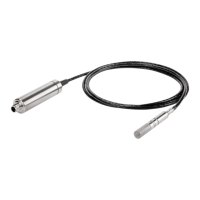3. Functional description
3.1 HUMICAP technology
Vaisala HUMICAPâ is a capacitive thin-film polymer sensor consisting of a substrate on which
a thin film of polymer is deposited between two conductive electrodes. The sensing surface is
coated with a porous metal electrode to protect it from contamination and exposure to
condensation. The substrate is typically glass or ceramic.
The thin-film polymer either absorbs or releases water vapor as the relative humidity of the
measurement environment rises or falls. The dielectric properties of the polymer film depend
on the amount of absorbed water. As the relative humidity around the sensor changes, the
dielectric properties of the polymer film change, and so does the capacitance of the sensor.
Capacitance is converted into a humidity reading. The HUMICAP sensor is complemented by a
temperature sensor, which is bonded together with the capacitive polymer on some of the
sensor variants. Additional output parameters such as dew point are calculated from the
readings measured by the sensors.
HUMICAP sensors with bonded temperature sensors are also known as composite sensors.
Probes with composite sensors can use the chemical purge function to maintain sensor
performance. They also implement condensation prevention functions that are a key element
in achieving an excellent stability and good condensation resistance in high humidity
applications.
The integrated sensor arrangement on the HMP1 and HMP9 probes is dierent from the
composite sensors used in the other HMP probes. However, they are also capable of using
condensation prevention heating and chemical purge.
3.2
Chemical purge
Chemical purge heats the sensor to a high temperature, which evaporates excess molecules
out of the sensor polymer. This minimizes the drift at the wet end of humidity readings, and
removes contaminants from the sensor element. The heating phase is followed by a cooling
phase where the sensor cools down to ambient temperature.
During chemical purge the values of the output parameters stay frozen at their last measured
values. Chemical purge takes a few minutes to complete, after which measurement continues
normally and updated values of output parameters are again available.
When ordered with chemical purge enabled, HMP model probes perform the purge at one day
intervals (known as interval purge). If desired, chemical purge can also be performed when
the probe is powered on (known as startup purge). Purge settings can be configured with
Insight software or using Modbus protocol.
To allow the chemical purge to be completed in a reasonable time, it will not be
started if the ambient temperature is below 0 °C (+32 °F).
Chapter 3 – Functional description
17

